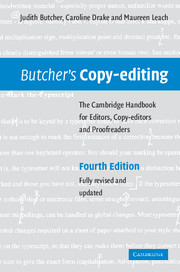Book contents
- Frontmatter
- Contents
- List of illustrations
- Preface to the fourth edition
- Preface to the third edition
- Preface to the second edition
- Preface to the first edition
- Acknowledgements
- 1 Introduction
- 2 Preliminary copy-editing, design and specimen pages
- 3 Preparing the text for the typesetter
- 4 Illustrations
- 5 Proofs
- 6 House style
- 7 Preliminary pages
- 8 Indexes
- 9 Other parts of a book
- 10 Bibliographical references
- 11 Literary material
- 12 Multi-author and multi-volume works
- 13 Science and mathematics books
- 14 Other special subjects
- 15 Reprints and new editions
- 16 On-screen editing
- Appendixes
- 1 Checklist of copy-editing
- 2 Book sizes
- 3 Abbreviations for states in the USA
- 4 Phonetic symbols
- 5 The Russian alphabet
- 6 Old English and Middle English letters
- 7 French and German bibliographical terms and abbreviations
- 8 Mathematical symbols
- 9 Hebrew
- 10 Arabic
- 11 Islamic, Chinese, Japanese and French Revolutionary calendars
- 12 Countries of the former USSR, Baltic states and former Yugoslavia
- 13 Proof correction symbols
- 14 How to check that an ISBN is correct
- Glossary
- Select bibliography and other resources
- Index
10 - Arabic
from Appendixes
Published online by Cambridge University Press: 05 August 2012
- Frontmatter
- Contents
- List of illustrations
- Preface to the fourth edition
- Preface to the third edition
- Preface to the second edition
- Preface to the first edition
- Acknowledgements
- 1 Introduction
- 2 Preliminary copy-editing, design and specimen pages
- 3 Preparing the text for the typesetter
- 4 Illustrations
- 5 Proofs
- 6 House style
- 7 Preliminary pages
- 8 Indexes
- 9 Other parts of a book
- 10 Bibliographical references
- 11 Literary material
- 12 Multi-author and multi-volume works
- 13 Science and mathematics books
- 14 Other special subjects
- 15 Reprints and new editions
- 16 On-screen editing
- Appendixes
- 1 Checklist of copy-editing
- 2 Book sizes
- 3 Abbreviations for states in the USA
- 4 Phonetic symbols
- 5 The Russian alphabet
- 6 Old English and Middle English letters
- 7 French and German bibliographical terms and abbreviations
- 8 Mathematical symbols
- 9 Hebrew
- 10 Arabic
- 11 Islamic, Chinese, Japanese and French Revolutionary calendars
- 12 Countries of the former USSR, Baltic states and former Yugoslavia
- 13 Proof correction symbols
- 14 How to check that an ISBN is correct
- Glossary
- Select bibliography and other resources
- Index
Summary
The following notes are intended to provide some guidance for copy-editors unfamiliar with Arabic who have to deal with it in a typescript, whether in Arabic script or in transliterated form.
Arabic script, no matter whether it is handwritten or typeset, is a cursive one, written from right to left. Only consonants and long vowels are normally shown in the script; there are orthographic signs to represent the short vowels (see below), but they are not usually shown except in the Koran, school books, and old or difficult texts (script in which the short vowels do appear is referred to as ‘vocalized’). There are no capital letters.
The table on p. 471 shows the twenty-eight letters in their traditional order, with their names, their various forms, and their transliteration according to two different systems: (1) a commonly used one and (2) the British Standard system (BS 4280: Transliteration of Arabic Characters). It will be seen from the table that there are two classes of letters:
those which can be connected both to a preceding and to a following letter; they have four possible forms
those which can be joined only to a preceding letter; they have only two possible forms.
- Type
- Chapter
- Information
- Butcher's Copy-editingThe Cambridge Handbook for Editors, Copy-editors and Proofreaders, pp. 470 - 474Publisher: Cambridge University PressPrint publication year: 2006



